论文题目英文翻译格式探析
- 格式:doc
- 大小:19.46 KB
- 文档页数:5
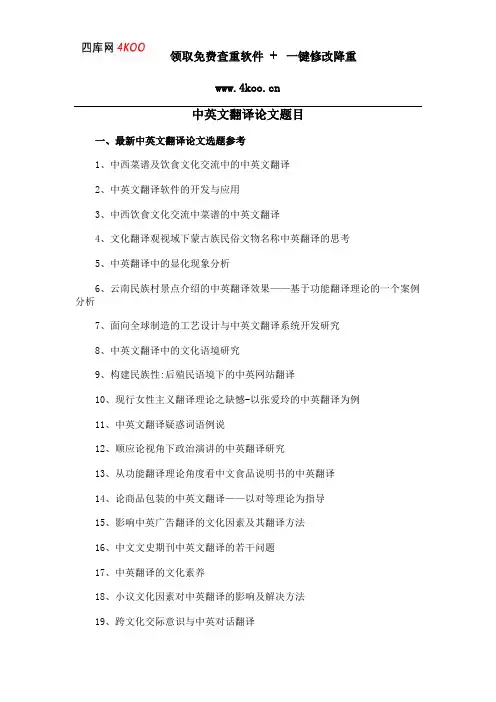
中英文翻译论文题目一、最新中英文翻译论文选题参考1、中西菜谱及饮食文化交流中的中英文翻译2、中英文翻译软件的开发与应用3、中西饮食文化交流中菜谱的中英文翻译4、文化翻译观视域下蒙古族民俗文物名称中英翻译的思考5、中英翻译中的显化现象分析6、云南民族村景点介绍的中英翻译效果——基于功能翻译理论的一个案例分析7、面向全球制造的工艺设计与中英文翻译系统开发研究8、中英文翻译中的文化语境研究9、构建民族性:后殖民语境下的中英网站翻译10、现行女性主义翻译理论之缺憾-以张爱玲的中英翻译为例11、中英文翻译疑惑词语例说12、顺应论视角下政治演讲的中英翻译研究13、从功能翻译理论角度看中文食品说明书的中英翻译14、论商品包装的中英文翻译——以对等理论为指导15、影响中英广告翻译的文化因素及其翻译方法16、中文文史期刊中英文翻译的若干问题17、中英翻译的文化素养18、小议文化因素对中英翻译的影响及解决方法19、跨文化交际意识与中英对话翻译20、中英语言翻译中的几种常见现象二、中英文翻译论文题目大全1、中英文翻译中的异化2、中英翻译中不同思维模式的转换3、中英翻译归化现象透视4、学术论文中英文翻译的不一致现象5、论中英人名翻译6、功能翻译理论角度的人力资源管理的中英翻译——以人事招聘与制度编制文本翻译为例7、“中华老字号”中英翻译存在的问题及策略研究8、北京地区高校校园标识语中英翻译调查研究9、从跨文化传播角度浅谈商标的中英文翻译10、数字出版中统计excel中英文翻译自动程序化的应用11、中西文化差异视角下的中英翻译12、“爱屋及乌”的中英翻译国俗语义差异13、从《毛选》英译看政治文献中英翻译的冗余度平衡14、景区标识语中英翻译实证研究15、中英字幕翻译中的文化差异及文化意象的处理策略16、论语法意识在中英翻译中的意义17、文化自觉与自信语境下的中英姓名翻译18、中西文化差异下的中英歌词翻译原则及方法19、从中西文化的差异性浅析中英翻译20、浅析电影作品里中英翻译所体现的文化差异三、热门中英文翻译专业论文题目推荐1、从功能理论视角谈旅游文本的中英翻译2、对九寨沟风景区标志牌中英文翻译的调查与建议3、浅析中英合同翻译语言层面上需要关注的几点要素4、论商品包装的中英文翻译—以对等理论问指导5、从文化交流层面谈中英文翻译时如何对待"异"与"同"6、以对等翻译理论指导商品包装的中英文翻译7、中英歌词翻译与文化传播8、中英文翻译中的文化空缺及翻译策略解析9、浅析谷歌翻译中英翻译的优缺点10、中英翻译问题剖析11、浅谈中英翻译比较12、红色在中英文翻译中的文化内涵与比较13、各种流行“族群”词语的中英文翻译14、中法文、中英文翻译中的文化“霸权主义”15、另辟蹊径,建立中英句子翻译结构新概念16、中英电影翻译中的文化意象17、中英翻译的不可译现象及译者处理对策--以《生死疲劳》葛浩文译本为例18、论《名利场》的语言艺术及其中英对照翻译19、我国公示语中英翻译研究概况20、英汉思维方式对比在中英翻译教学中的应用四、关于中英文翻译毕业论文题目1、动态顺应与中英人名翻译2、建构还是“解构”:中英大学翻译课教学模式之对比研究3、以中西文化差异探析中英歌词翻译4、武术中英翻译的现状及对策研究5、中英文翻译中文化空缺现象及翻译策略6、论海事英语中英文翻译7、基于Web的中英术语翻译获取方法研究8、中英文翻译视角转换浅议9、中英文化翻译: 当代中国文本译释个案研究10、跨文化翻译中的关联理论应用——以钱钟书《围城》中英翻译为例11、中英翻译课比较12、中国文学“走出去”的现状和前景——对2011中英翻译文学论坛的思考13、诺德功能模式个案分析:楼盘宣传册中英翻译14、中英翻译视角下的歇后语分类及其应用15、中英文翻译中文化空缺现象及翻译对策16、中英语言翻译中的不等同性17、中英翻译比较研究18、论商标中英文翻译的原则19、从红楼梦两个英译本看中英翻译的不可译性20、南阳市对外宣传公示语中英文翻译规范性调查与研究五、比较好写的中英文翻译论文题目1、中英歌曲翻译研究的现状及策略2、中英文化翻译中从不可译性到可译性3、试析关联理论在翻译中的应用——以旅游资料的中英翻译为例4、中英文翻译中的文化忠实与叛逆研究5、旧金山汉语桥比赛将举行中英文翻译或成最难考题6、浅谈文化差异视角下的中英翻译7、浅谈中英翻译中颜色词的异同8、功能派翻译理论指导下的外宣中英翻译研究9、从功能翻译理论角度浅议公共标志中英翻译10、浅谈我国旅游景区有关的中英翻译11、日本书名的中英文翻译对比研究12、中英文翻译的现代教育方法13、一种实现网页中英文翻译的系统和方法14、中英词汇翻译不对等现象——从"红糖"的翻译谈起15、浅谈中英文翻译的技巧16、航海英语中英文翻译论谈——船长考证英语辅导教学体会17、文化因素对中英翻译的影响及处理18、对中英翻译中存在的文化差异的分析与研究19、政府工作报告中英翻译中的衔接手段对比研究20、文化语境在中英文翻译中的深刻影响。
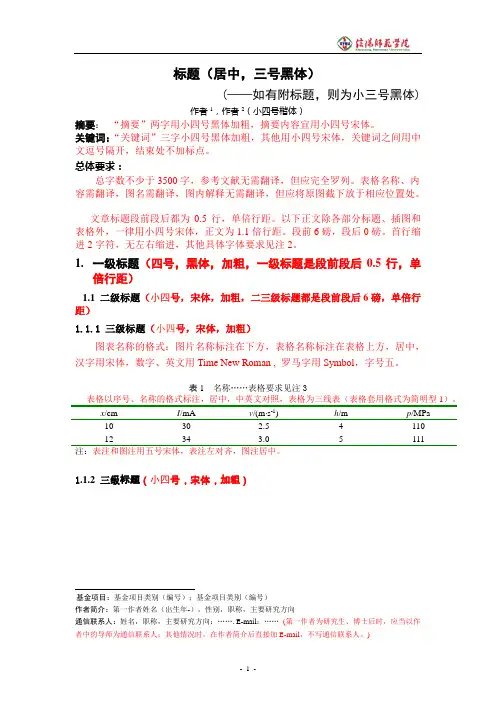
标题(居中,三号黑体)(——如有附标题,则为小三号黑体)作者1,作者2(小四号楷体)摘要:“摘要”两字用小四号黑体加粗,摘要内容宜用小四号宋体。
关键词:“关键词”三字小四号黑体加粗,其他用小四号宋体,关键词之间用中文逗号隔开,结束处不加标点。
总体要求:总字数不少于3500字,参考文献无需翻译,但应完全罗列。
表格名称、内容需翻译,图名需翻译,图内解释无需翻译,但应将原图截下放于相应位置处。
文章标题段前段后都为0.5行,单倍行距。
以下正文除各部分标题、插图和表格外,一律用小四号宋体,正文为1.1倍行距。
段前6磅,段后0磅。
首行缩进2字符,无左右缩进,其他具体字体要求见注2。
1.一级标题(四号,黑体,加粗,一级标题是段前段后0.5行,单倍行距)1.1 二级标题(小四号,宋体,加粗,二三级标题都是段前段后6磅,单倍行距)1.1.1 三级标题(小四号,宋体,加粗)图表名称的格式:图片名称标注在下方,表格名称标注在表格上方,居中,汉字用宋体,数字、英文用Time New Roman , 罗马字用Symbol,字号五。
表1 名称……表格要求见注3表格以序号、名称的格式标注,居中,中英文对照,表格为三线表(表格套用格式为简明型1)。
x/cm I/mA v/(m⋅s-1) h/m p/MPa10 30 2.5 4 11012 34 3.0 5 111注:表注和图注用五号宋体,表注左对齐,图注居中。
1.1.2 三级标题(小四号,宋体,加粗)基金项目:基金项目类别(编号);基金项目类别(编号)作者简介:第一作者姓名(出生年-),性别,职称,主要研究方向通信联系人:姓名,职称,主要研究方向:……. E-mail:……(第一作者为研究生、博士后时,应当以作者中的导师为通信联系人;其他情况时,在作者简介后直接加E-mail,不写通信联系人。
)图1 名称……图形要求见注4图号和图名用五号宋体,图下居中。
1.2 二级标题(小四号,宋体,加粗)2.一级标题注释统一采用页下注:五号宋体。
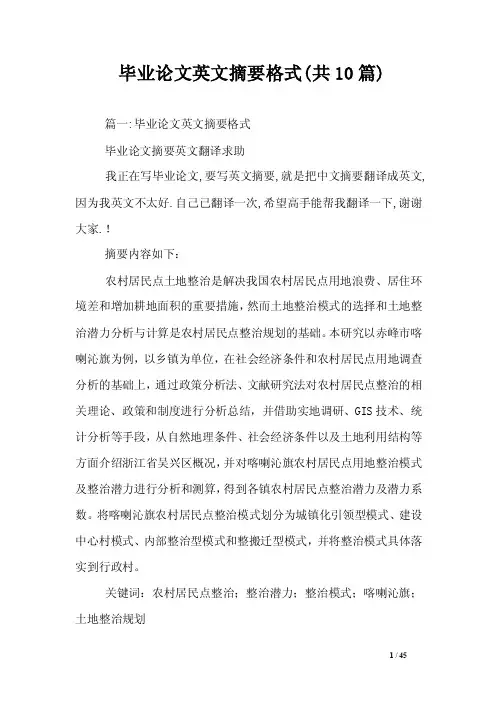
毕业论文英文摘要格式(共10篇)篇一:毕业论文英文摘要格式毕业论文摘要英文翻译求助我正在写毕业论文,要写英文摘要,就是把中文摘要翻译成英文,因为我英文不太好.自己已翻译一次,希望高手能帮我翻译一下,谢谢大家.!摘要内容如下:农村居民点土地整治是解决我国农村居民点用地浪费、居住环境差和增加耕地面积的重要措施,然而土地整治模式的选择和土地整治潜力分析与计算是农村居民点整治规划的基础。
本研究以赤峰市喀喇沁旗为例,以乡镇为单位,在社会经济条件和农村居民点用地调查分析的基础上,通过政策分析法、文献研究法对农村居民点整治的相关理论、政策和制度进行分析总结,并借助实地调研、GIS技术、统计分析等手段,从自然地理条件、社会经济条件以及土地利用结构等方面介绍浙江省吴兴区概况,并对喀喇沁旗农村居民点用地整治模式及整治潜力进行分析和测算,得到各镇农村居民点整治潜力及潜力系数。
将喀喇沁旗农村居民点整治模式划分为城镇化引领型模式、建设中心村模式、内部整治型模式和整搬迁型模式,并将整治模式具体落实到行政村。
关键词:农村居民点整治;整治潜力;整治模式;喀喇沁旗;土地整治规划翻译软件翻出来的你也要啊?Ruralresidentiallandreclamationistosolvethewasteofruralresidentialland,poorlivingenvironmentandtheimportantmeasurestoincrease theareaof cultivated land,butland management modechoiceandland reclamation potential analysis and calculation isthe foundation oftherural residential renovation plan.This studyinchifengcity kaLaQinQi, for example,inthevillages and towns,inthesocialand economicconditions andrural residential land,onthebasisof investigation and analysis, throughpolicy analysis, literature researchonrural residential renovation relatedtheory,policyandsystem analysis,andwiththeaidofon-the-spot investigation, statistical analysisandGIS,fromthenatural geographical conditions, socialeconomic conditions andlanduse structure in zhejiang province were introduced fromthe aspects suchasWuXing area,andthe kaLaQinQipatternsofruralresidentiallandregulationandcontrolpotential analysisandcalculation,fortownsofrural settlements renovation potentialandpotential coefficient.WillkaLaQinQiruralresidentialrenovationmodeisdividedintothemodelofurbanizationleadZhongXincunmode,constructiontype,。
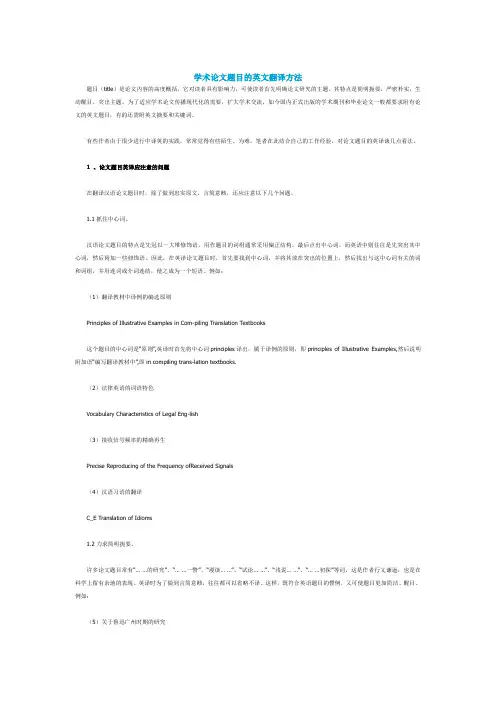
学术论文题目的英文翻译方法题目(title)是论文内容的高度概括,它对读者具有影响力,可使读者首先明确论文研究的主题。
其特点是简明扼要,严密朴实,生动醒目,突出主题。
为了适应学术论文传播现代化的需要,扩大学术交流,如今国内正式出版的学术期刊和毕业论文一般都要求附有论文的英文题目,有的还需附英文摘要和关键词。
有些作者由于很少进行中译英的实践,常常觉得有些陌生、为难。
笔者在此结合自己的工作经验,对论文题目的英译谈几点看法。
1 、论文题目英译应注意的问题在翻译汉语论文题目时,除了做到忠实原文,言简意赅,还应注意以下几个问题。
1.1抓住中心词。
汉语论文题目的特点是先冠以一大堆修饰语,用作题目的词组通常采用偏正结构,最后点出中心词。
而英语中则往往是先突出其中心词,然后附加一些修饰语。
因此,在英译论文题目时,首先要找到中心词,并将其放在突出的位置上,然后找出与这中心词有关的词和词组,并用连词或介词连结,使之成为一个短语。
例如:(1)翻译教材中译例的编选原则Principles of Illustrative Examples in Com-piling Translation Textbooks这个题目的中心词是“原则”,英译时首先将中心词principles译出,属于译例的原则,即principles of Illustrative Examples,然后说明附加语“编写翻译教材中”,即in compiling trans-lation textbooks.(2)法律英语的词语特色Vocabulary Characteristics of Legal Eng-lish(3)接收信号频率的精确再生Precise Reproducing of the Frequency ofReceived Signals(4)汉语习语的翻译C_E Translation of Idioms1.2力求简明扼要。
许多论文题目常有“… …的研究”、“… …一瞥”、“漫谈… …”、“试论… …”、“浅说… …”、“… …初探”等词,这是作者行文谦逊,也是在科学上留有余地的表现。
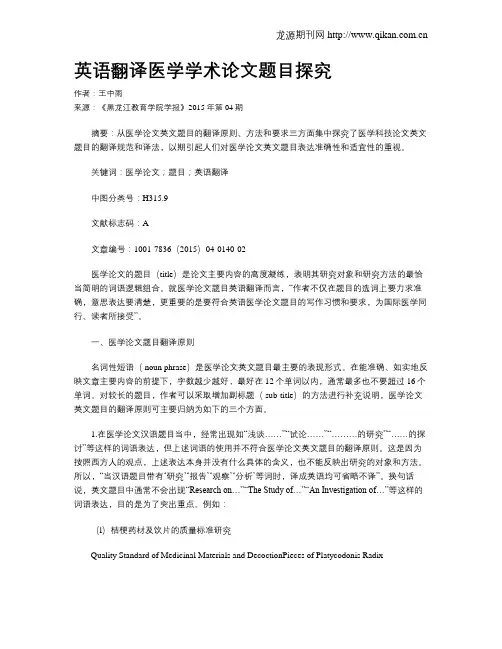
英语翻译医学学术论文题目探究作者:王中雨来源:《黑龙江教育学院学报》2015年第04期摘要:从医学论文英文题目的翻译原则、方法和要求三方面集中探究了医学科技论文英文题目的翻译规范和译法,以期引起人们对医学论文英文题目表达准确性和适宜性的重视。
关键词:医学论文;题目;英语翻译中图分类号:H315.9文献标志码:A文章编号:1001-7836(2015)04-0140-02医学论文的题目(title)是论文主要内容的高度凝练,表明其研究对象和研究方法的最恰当简明的词语逻辑组合。
就医学论文题目英语翻译而言,“作者不仅在题目的选词上要力求准确,意思表达要清楚,更重要的是要符合英语医学论文题目的写作习惯和要求,为国际医学同行、读者所接受”。
一、医学论文题目翻译原则名词性短语( noun phrase)是医学论文英文题目最主要的表现形式。
在能准确、如实地反映文章主要内容的前提下,字数越少越好,最好在12个单词以内,通常最多也不要超过16个单词。
对较长的题目,作者可以采取增加副标题( sub-title)的方法进行补充说明,医学论文英文题目的翻译原则可主要归纳为如下的三个方面。
1.在医学论文汉语题目当中,经常出现如“浅谈……”“试论……”“………的研究”“……的探讨”等这样的词语表达,但上述词语的使用并不符合医学论文英文题目的翻译原则。
这是因为按照西方人的观点,上述表达本身并没有什么具体的含义,也不能反映出研究的对象和方法。
所以,“当汉语题目带有‘研究’‘报告’‘观察’‘分析’等词时,译成英语均可省略不译”。
换句话说,英文题目中通常不会出现“Research on…”“The Study of…”“An Investigation of…”等这样的词语表达,目的是为了突出重点。
例如:(l)桔梗药材及饮片的质量标准研究Quality Standard of Medicinal Materials and DecoctionPieces of Platycodonis Radix依据题目的翻译原则,上例在翻译成英文题目时无须翻译出“研究”二字,即不用写“The Study of…”。
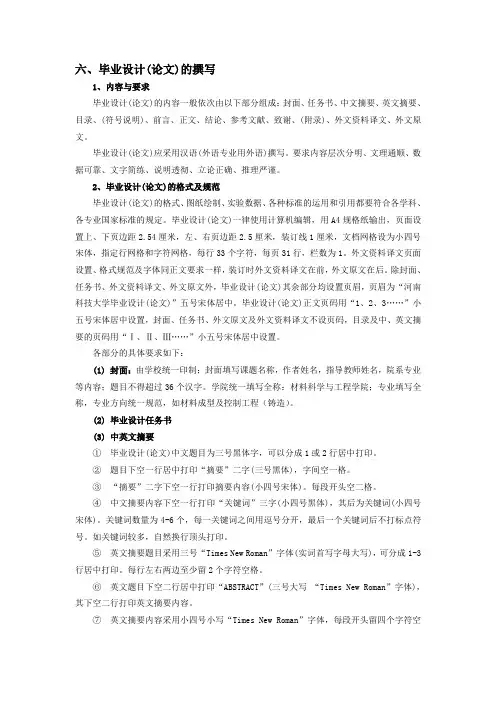
六、毕业设计(论文)的撰写1、内容与要求毕业设计(论文)的内容一般依次由以下部分组成:封面、任务书、中文摘要、英文摘要、目录、(符号说明)、前言、正文、结论、参考文献、致谢、(附录)、外文资料译文、外文原文。
毕业设计(论文)应采用汉语(外语专业用外语)撰写。
要求内容层次分明、文理通顺、数据可靠、文字简练、说明透彻、立论正确、推理严谨。
2、毕业设计(论文)的格式及规范毕业设计(论文)的格式、图纸绘制、实验数据、各种标准的运用和引用都要符合各学科、各专业国家标准的规定。
毕业设计(论文)一律使用计算机编辑,用A4规格纸输出,页面设置上、下页边距2.54厘米,左、右页边距2.5厘米,装订线1厘米,文档网格设为小四号宋体,指定行网格和字符网格,每行33个字符,每页31行,栏数为1。
外文资料译文页面设置、格式规范及字体同正文要求一样,装订时外文资料译文在前,外文原文在后。
除封面、任务书、外文资料译文、外文原文外,毕业设计(论文)其余部分均设置页眉,页眉为“河南科技大学毕业设计(论文)”五号宋体居中。
毕业设计(论文)正文页码用“1、2、3……”小五号宋体居中设置,封面、任务书、外文原文及外文资料译文不设页码,目录及中、英文摘要的页码用“Ⅰ、Ⅱ、Ⅲ……”小五号宋体居中设置。
各部分的具体要求如下:(1) 封面:由学校统一印制;封面填写课题名称,作者姓名,指导教师姓名,院系专业等内容;题目不得超过36个汉字。
学院统一填写全称:材料科学与工程学院;专业填写全称,专业方向统一规范,如材料成型及控制工程(铸造)。
(2) 毕业设计任务书(3) 中英文摘要①毕业设计(论文)中文题目为三号黑体字,可以分成1或2行居中打印。
②题目下空一行居中打印“摘要”二字(三号黑体),字间空一格。
③“摘要”二字下空一行打印摘要内容(小四号宋体)。
每段开头空二格。
④中文摘要内容下空一行打印“关键词”三字(小四号黑体),其后为关键词(小四号宋体)。
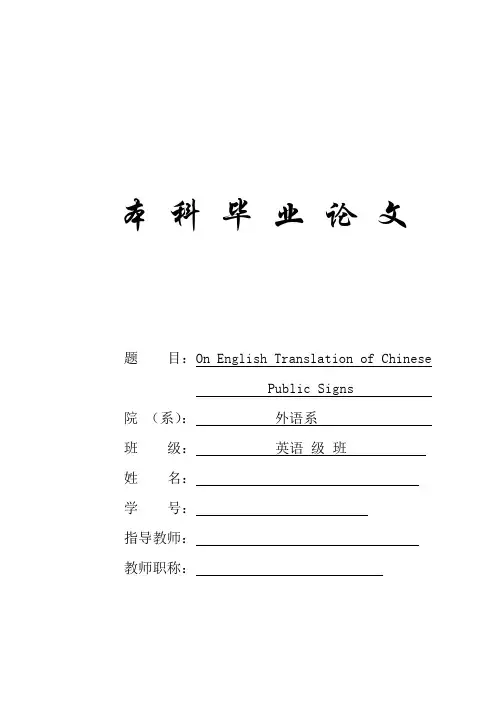
本科毕业论文题目:On English Translation of ChinesePublic Signs 院(系):外语系班级:英语级班姓名:学号:指导教师:教师职称:汉英公示语的翻译摘要公示语向来被称作“城市的脸孔",是给所有到中国来的外国人士留下第一印象的中国名片。
然而,公示语翻译的错误比比皆是,这大大影响了公示语作用的发挥,削弱了我国的国际形象。
为了树立我国良好的国际形象,不断规范和完善城市公示语的翻译成为了一项亟待完成的工作。
基于以上原因,作者尝试从理论和实践的角度分析现今汉英公示语翻译中所存在的一些问题。
通过对大量标准以及问题公示语翻译的深入观察分析,作者对公示语的一般特征进行了总结并对公示语翻译中出现的问题进行了分类,从而在实践观察和对相关理论深入研究的基础上提出相应的翻译策略。
翻译并不仅仅是跨语言行为,它更是一种文化信息的传递。
公示语的翻译同样如此。
得体的公示语翻译不仅在语言上要无懈可击,在文化信息传递上也要雅俗共赏。
本文还对公示语的概念做出了解释,并根据目的需求与功能两种标准对公示语做了分类。
在介绍公示语的特征时,作者将其分为语言特征与功能特征,特征与分类不同,也决定了需要采取不同的翻译策略。
关键词:汉英翻译;公示语;问题;翻译策略On English Translation of Chinese PublicSignsAbstractPublic signs, which have alway s been referred to “face of city”, are the first impression of China for the people who come to China. However, the ubiquitous translation mistakes of public signs greatly undermine the international image of China. So,specificating and constantly perfecting the translation of public signs have become an urgent work in order to establish a good international image.The paper ventures an attempt to analyze the current problems existing in the C-E translation of public signs and to seek proper translational strategies both from the perspectives of theory and practice.By closely observing numerous samples of both standard and problematic translation of signs,the author manages to generalize the characteristics of public signs and to categorize the problems and mistakes in the current C-E translation of public signs.Then, proper translational strategies are proposed on the basis of in-depth study of relevant theories and keen observation of practice.Translation is not merely a cross-linguistic activity, but more of a transmission of cultural information.The translation of public signs is no exception.An appropriate translation of public sign should not only belinguistically correct, but also culturally acceptable.This paper expresses the meaning of the public signs and classify the signs according to the standards of objective demand and function. And the characteristics of the public signs are different studied from linguistic features and functional features,which determines to adopt different translation strategies.Key words: Chinese-English translation public sign problems translation strategyContents摘要 (I)Abstract (II)CHAPTER I Introduction (1)1.1 O bjective of the study (1)1.2 Significance of the study (1)1.3 Structure of the paper (2)CHAPTER II General Introduction to Public Signs (3)2.1 Definition of Public Signs (3)2.2 Functions of Public Signs (3)2.2.1 Directing function (4)2.2.2 Prompting function (4)2.2.3 Restricting function (4)2.2.4 Compelling function (5)CHAPTER III Analysis on Problems in C-E Translation of Public Signs (6)3.1 Linguistic translation problems (6)3.1.1 Spelling errors (6)3.1.2 Grammatical errors (6)3.1.3 Wrong dictions (7)3.2 Cultural translation problems (7)CHAPTER IV Strategies of C-E Public Signs Translation and Requirementfor Translator (9)4.1 Principles of C-E translation of Public Signs (9)4.1.1 Clearness (9)4.1.2 Conciseness (10)4.1.3 Simple words (10)4.2 Methods of C-E translation of Public S igns (11)4.2.1 Modification (11)4.2.2 Addition (11)4.2.3 Omission (12)4.2.4 Mutual transformation of affirmative and negativee xpressions (13)4.3 Requirement for the t ranslators (13)CHAPTER V Conclusion (15)Acknowledgements (16)Works Cited (17)CHAPTER I Introduction1.1Objective of the studyThe research objective of the study is to examine the translation problems in the Chinese-English public signs translation and further propose the translation strategies as well as principles suitable for specific groups.The studies begin with the careful and long period of observation of the problems existing in the public signs translation. On the basis of the classification of the translation errors proposed by Christiane Nord, the author aims at the most appropriate translation strategies for each type. With the examination of sufficient sources, the author finds that it is not difficult to eliminate the errors at linguistic level since the text of the public signs is less complex than documentary and other instrumental texts due to its conciseness and directness features (Ni 18).1.2 Significance of the studyPublic S igns affect people’s life in a tremendous way. When somebody smokes, it is the public sign that stops him. In fascinating and mysterious spots where we have never been to, it is the public sign that teaches us related knowledge. Foreign visitors from all walks of life,such as entrepreneurs,professors,students and tourists come to China for various purposes.But for most of them,they know little about Chinese.In this case,it is necessary to translate Chinese public signs into English for the convenience of these foreign visitors.In this case, a proper translation helps establish a good image of China and enhance the cultural communication.1.3 Structure of the paperThe paper is structured with five chapters:The first chapter is a general introduction to the thesis, including the objective of the study, the structure of the thesis and the significance of the study. The second chapter makes a general introduction to public sign, including the definition and functions of public sign. The third chapter focuses on the problems of C-E translation of public signs from linguistics and cultural perspectives. The fourth chapter deals with translation strategies of C-E public signs in connection with principles, methods and the standardization for the translators, including modification, addition, omission and mutual transformation of affirmative and negative expressions. And the fifth chapter draws a conclusion to the paper,in which the author appeals for translators and scholars to make contributions to the C-E translation of public signs.CHAPTER II General Introduction to Public Signs2.1 Definition of Public SignsPublic Signs,which are usually called“signs”,include public notices,advertisements,slogans and expressions on the public signs.Public signs refer to “signs” in English and are defined in different ways.Ac cording to Longman Dictionary of Contemporary English(1997),a sign is a piece of paper, metal, or wood with words or a picture that gives information,warnings,or instructions.In that sense, public sign is the general terms for indicators,signs,traffic signs, posters, slogans, warning, short notices,short instructions,stickers,and are becoming the catch word and the buzzword.All in all, public signs are so widely used and played important roles in our daily life.2.2 Functions of Public SignsPublic signs are essential to the normal operation of the society and their influence is also visible in almost every aspect of our daily life.Sometimes,we have to admit that our lives cannot do without the proper guidance that public signs provide to us.However, what usually happens is that we are prone to be bewildered by various public signs and the enormous information they convey to us.Therefore, it would be necessary to classify the public signs in terms of their functions as well as the status of information that they deliver.2.2.1 Directing functionDirecting is the most basic function of public signs, t his type of public signs is used to give readers related information about what the institution is,what it deals with and what kind of service it can provide.For example:Take Away(外卖),Gas Station(加油站),Emergency Exit(紧急出口),Business Hours(营业时间),Pause(暂停),Menu(菜单),Airport Security(机场安检).From the examples above we may tell that the language and the tone of these public signs are generally neutral,reflecting no attitude towards receptors.Therefore,public signs of this kind are purely informative rather than vocative.2.2.2 Prompting functionPromoting signs are similar to the directive ones in their informative function. While the difference is the former .carries the tone of warning,reminding the readers to pay some attention to certain things or activities.For example:Keep Clear(请保持清洁), Keep Silence(请保持安静),Wet Paint(油漆未干),Fully Booked(客满),Beware of Pickpockets(小心扒手),Maximum Height(限高).2.2.3 Restricting functionPublic Signs with restricting function impose restriction or even prohibition on receptors.The language used in this kind of signs are simple and direct but are not in rude,tough or impolite way.We can list some of them as following:Pay In Cash(现金支付),Slow Out(减速慢行),Keep Silence(保持安静),30 Minutes Parking(限停30分钟),Seat By Number(对号入座), Stand In Line(排队等候).2.2.4 Compelling functionCompelling function is the strongest considerable mood.It is used to prohibit the readers to do something or must do something.The language used is usually forceful,with no possibility of making a compromise.The sign with this function which we mostly often see is“No Smoking禁止吸烟”,that is to say that smoking iscompletely forbidden.Imperative sentence is not enough to express this strong mood,usually, we use“No+…”form,for example,“No Food禁止携带食物”.More examples:Don’t Touch(禁止触摸),No Cameras(禁止拍照),No Visitors(游客止步),No Trucks(卡车禁止通行),Dogs Not Allowed(禁止带狗入内).Translation of the public signs, translators not only need to grasp their function features since we use different mood to express different function,but also should keep their language features in mind during the translating.CHAPTER III Analysis on Problems in C-E Translation ofPublic Signs3.1 Linguistic translation problemsLinguistic translation errors are often due to deficiencies in the translator's source or target language competence (Nord 77).And in his book Pragmatics and English Language He Ziran explained that by making linguistic errors,the translators and interpreters fail to conform to the target language structures,instead they blindly translate the source text in their own language structures(157).Professor Wang Yinquan, classifies linguistic translation errors into: spelling mistakes, grammar mistakes and wrong diction (32).3.1.1 Spelling errorsSpelling errors are typical translation problems in bilingual public signs. The reasons for this type of errors attribute to the three factors: the incompetent language acquisition, the laziness of the translator when writing, the uncertainty of the correct spelling, among which the third type is most difficult to be identified. For example: 3.1.2 Grammatical errorsApart from spelling mistakes,many grammatical errors also occur in the translated signs.These errors appear in various forms,most of which result from the translator’s poor command of the English language or irresponsible working attitude.As a result,the translated public signs cannot be of any help to the target readers.Sometimes they may do damage the image of our city.For example: 室内停车场(Car Park)—It may be apparent to tell that the translator intends to use the word“park”as a noun to express the meaning of parking place for automobiles.However, as a noun the word actually means a public place wherepeople can entertain themselves with the landscape or public facilities in it.Therefore, it will be advisable to use the gerund form of the word “park”and translate it as“Indoor Parking”.3.1.3 Wrong dictionsWrong Dictions occur when t he translator doesn’t make right choices of words in the target culture that will lead to unsuccessful expression of the correct information to the target text receivers. In fact, many English words have more than one meaning. Sometimes one word used to describe the source culture may not be applicable in another situation and the diction is conditioned. The words chosen for each text might vary according to different semantic and syntactic features in different situations. For example:请勿采摘花朵--Please Don’t Pick Flowers. Here use“pick”to describe the gesture. In fact, there is a variety of expression in English corresponding with “摘”, of which one of the expressions is “pick”. But in the given circumstances, “pick”doesn’t equate with “摘”. “Pick”means to select among a variety of choices, but here the sender wants to persuade people not to pluck the flowers. The error is due to the confusion about the seemingly identical usage of one word.3.2 Cultural translation problemsAs we all know, people in different cultures may view the same thing in different ways and differ in the perspective of cognition.At the same time,they express the same idea in different way.As far as Chinese and English are concerned, culture differences are tremendous.Translation breaks down language barriers and thus realizes communication between cultures using different languages. In this sense, target readers approach to people of source culture whose beliefs, backgrounds, perception of the world are distinct from their own.For example:古装照相It is ancient to pack photo“古装照相”is a typical Chinese term. In English, people don’t have the correspondent term. According to the public signs translation convention, the signs which are composed of Chinese noun phrases are expected to have the same structure in English version, so the sentence is not correct in terms of the sentence structure. Also concerning the meaning of the sentence, it is wrongly translated that the foreigners can’t get the message which leads to the pragmatic failure of the assumed function. The correct version should be “Photos in ancient costume”.CHAPTER IV Strategies for C-E Public Signs Translation4.1 Principles of C-E translation of Public SignsAs we know, different functions need different language forms to convey and each language style possesses its special principles.Ni Chuanbin and Liu Zhi analyze the language principles of public signs in their essay“The Principles for C-E Translation of Public Signs and its Cases Study”,published in Shanghai Journal of Translators for Science and Technology(18).Firstly, the signs are on a board,so the language on the signs should be in concise way due to the comparatively small space.Secondly, some public signs must draw the public’s attention at the first sight and the readers can catch its meaning very quickly and correctly, especially the traffic signs,such as“Abrupt Turn Left Ahead前方急转弯”,the applied words should be simple ones instead of rare ones.At last,the meaning of the signs should be clear and easy to read,the sign is set without ambiguity. So we can know the principles in details as following:4.1.1 ClearnessDue to the short time the target reader can spend on reading the signs the meaning of the signs should be clear and easy to be understood.As the target readers are the common people who have little knowledge related to the concerned topic,the signs should directly hit the point and there should exist no vagueness.“严禁客货混装Don’t put passengers and cargos together”. It is hazy and not clearness. So the sign“严禁客货混装”should be translated into“No passengers on Trucks”.The signs are set for the public and not every reader is professional,therefore when we translate signs,we should hit the point directly and clearly and should notjust talk around the bush.4.1.2 ConcisenessAccording to William Strunk,Jr.and E.B.White in 1979(Joan Pinkham):“Vigorous writing is concise.A sentence should contain no unnecessary words,a paragraph no unnecessary sentences,for the same reason that a drawing should have no unnecessary lines and a machine no unnecessary parts.”It is also true of language of public signs.Usually, the readers for public signs just give a quick look at the board with signs on when they pass by.So the language on it need not be in a complete sentence,a phrase or just a word is enough,for example,“No Smoking禁止吸烟”,“Open正在营业”,we need not use sentences“Please do not smoke”an“We are on business”.4.1.3 Simple wordsPublic Signs are set for the public,target readers of this kind of materials are ordinary people,not only the native English speakers,but also other foreigners who know a little English and English is not his mother language,and target readers also include overseas Chinese who is not a English native speaker.If the English version is full of rare words and expression,it will cause a pragmatic failure of communication for public signs.There is always a small restaurant at the airport to provide fast food for the passengers,the English tablet should be“Snacks”instead of“Refection”,the later one is not often be used nowadays and we cannot find it in the dictionaries published in recent years.Take all another example,“景区环境卫生,需要您的维护”,should we translate it into“Environmental Sanitation of the Scenic Spot Needs Your Conserve”? The words“sanitation”and“environmental”are not familial words for the public,we had better use“Keep Clear”or“No Littering”.From the above,in order to make target readers catch the meaning at first glance,we should use the concise,clear, simple words and expressions in C-E translation of public signs.4.2 Strategies of C-E translation of Public Signs4.2.1 ModificationGenerally speaking, it is always the case that the reader in the culture of the target language may not share the cultural background of the source language.Therefore,when dealing with culture-loaded words and idioms,the translator sometimes has to make cultural modification so as to generate the same feedback from the target text reader with that of the source text reader, and as for the translation of public signs, it is no exception.For examples:西湖的虎跑泉—Tiger Running Spring, in this public sign,the translator obviously take the actual meaning of the sign for granted by translating the word“虎跑”as“tiger running”which means that a tiger runs for the spring.4.2.2 AdditionSome public signs,especially signs at scenic spots,tend to include dynasties,legends or other cultural elements,while most foreign visitors lack the background knowledge of China.If the public signs are translated literally, the English versions may confuse the target readers.Thus we should adopt the translation strategy of addition to supply necessary information on the basis of accurate comprehension of the original public signs.For example:谢绝游客入内Closed To Visitors禁止在墙上涂写No Scribbling On The Wall4.2.3 OmissionDue to different aesthetic standards and cultures,Chinese writing tends to include flowery words,four-word phrases or some culture elements which are special to the Chinese culture.However, English writing pursues clear and simple expressions.In How to Help Foreigners Know China,Duan Liancheng holds a view that with the development of tourism in recent years,large numbers of brochures pamphlets and pictorials have been published for foreign tourists.A common weakness of these materials is full of flowery words and cultural elements of China which may confuse the target readers (Duan 286). So the translator should omit some adjectives or cultural elements which may pose barriers to the target readers.Then the English version will be easily understood by them.For example:1.Source Text:慢速行驶Version A:You must drive slowly.Version B:Drive slowly2.Source Text:前方学校Version A:There is a school ahead.Version B:School Ahead4.2.4 Mutual transformation of affirmative and negative expressionsMutual transformation of affirmative and negative expressions is a common strategy in translating the text of one language to the other.It is especially useful for transcending the translational difficulties due to different ways or habits of expressing ideas in Chinese and English.In translating public signs,mutual transformation of affirmative and negativeexpressions is necessary as well.In western countries especially in English—speaking countries,people tend to avoid using negative expressions in public literatures as much as possible in case that unpleasant emotion or feeling would be aroused on the part of the receptor.However, because of the difference in cultural values,negative expressions are more frequently used in Chinese public signs.Therefore,according to the theory of cultural translation, we should adopt the translational method of“Domestication”.For example: “社会车辆禁止入内”,it is a kind of negative expression in Chinese language. While it should be translated into “Staff Only” in English, it is affirmative.4.3 Requirement for the translatorsThe C-E translation of public signs is by no means an easy job and it requires that a translator be serious and accountable in attitude, and proficient in both the source and the target languages at the same time.A good translator should always bear in mind the features and characteristics of public signs.Only if the translators acquire the expertise in the source and target languages as well as the source and target cultures can they produce qualified versions. In addition, as for the making process of signs, the local governments should choose reliable and efficient sign-making units by means of bidding to undertake the job.And the translation should be tested in the foreigners to ensure the acceptability.Then a supervision organization in charge of public signs should be established to make sure that some common English versions are accurate and unified.CHAPTER V ConclusionBased on the previous discussions and analyses, the major findings of this study can be summarized as follow:Firstly, the linguistic translation problems account for the reasons for spelling, grammatical and wrong dictions problems. Translators should improve their language acquisition in dealing with the problems.Secondly, as to cultural problems, the translators are advised to adopt communicative translation. To be more specific, the translation strategies are adaptation, restructuring, semi-literal translation, etc.Thirdly, the C-E translation involves the principles and the methods. The principles include three points of clearness, conciseness and simple words. The translation takes place in a given situation or in another sense, the methods of C-E translation of public signs should be divided into four: modification, addition, omission and mutual transformation of affirmative and negative expressions.Actually, the problems of the translation of public signs are far more complicated than the thesis.The problems that have been discussed and proposed with strategies to are just a tiny tip of the whole iceberg.With the development of the society, it is sure that more and more public signs will come out by taking various forms,and new problems in translating them will turn up.Therefore,the classification of public signs and mistranslation, as well as the strategies for the betterment of the current status of sign translation, although the author attempts to let them be, are not all-inclusive and universally accurate. It is a long and hard way for us to go.AcknowledgementsI would like to express my heartfelt thanks to those who offered me their sincere support and encouragement in the process of my thesis writing.First of all, I’d like to give my sincere thanks to my teacher, Kangbing. She has given me valuable instructions on my study. Whenever I need her help, she always enthusiastically offers me. During the process of the completion of the thesis, from the researches chosen to be analyzed to the final composition, her patient and helpful instructions have benefited me a great deal. Her strict requirements have enabled me to learn how to do research work, and her kind encouragement have been supporting me to the end.Second, my true thanks also go to all the teachers who guide me in the field of business English.Finally, my family and friends give me great encouragement and support during the composition of the thesis. I’d like to send them my heartfelt thanks too.Work CitedBaker, Mona. Encyclopedia of Translation Studies[M]. Shanghai: Shanghai Foreign Language Education Press, 2004:104.Nida, Eugene A.&C. R. Taber. The Theory and Practice of Translation[M]. Leiden:E.J. Brill, 1969:89-97.Nord, Christiane. Translating as a Purposeful Activity[M]. Shanghai: Shanghai Foreign Language Education Press, 2001:77.Pinkham John.The Translator’s Guide to Chinglish[M].Beijing:Foreign Language Teaching and Research Press, 2000:99.Snell-Hornby, Marry. Translation Studies: an Integrated Approach[M]. Shanghai: Shanghai Foreign Language Education Press, 2001:267-271.Wilss,Wolfman.The Science of Translation-Problems and Methods[M].Shanghai:Shanghai Foreign Language Education Press, 2001:125.包惠南.文化语境与语言翻译[M]. 北京:中国对外翻译出版公司, 2002:78-86. 陈定安.英汉比较与翻译[M]. 北京:中国对外翻译出版公司, 1988:271-275. 陈淑莹.标示语英译的语用失误探析[J]. 四川外语学院学报, 2006 ,1:117-120.戴宗显, 吕和发. 公示语汉英翻译研究---以2012年奥运会主办城市伦敦为例[J]. 中国翻译, 2005,6:38-42.何自然.语用学概论[M].长沙:湖南教育出版社,1988:157.赖少华.浅谈公示语的翻译现状及对策----以广州地铁站公示语翻译为例[J].湖北广播电视大学学报, 2009,6:112-112.吕和发, 单丽平.汉英公示语词典[M]. 北京: 商务印书馆, 2004:38..倪传斌,刘治.标记语的英译原则及实例分析[J].上海科技翻译, 1998,2:18-20.单爱民.谈英语公示用语的语言特点与汉英翻译[J]. 北京第二外国语学院学报, 2002,5:76-79.王晓娟. 从功能理论看公示语翻译---以南京城市公示语为例[J]. 湖北经济学院学报:人文社会科学版, 2008,4:119-120.。


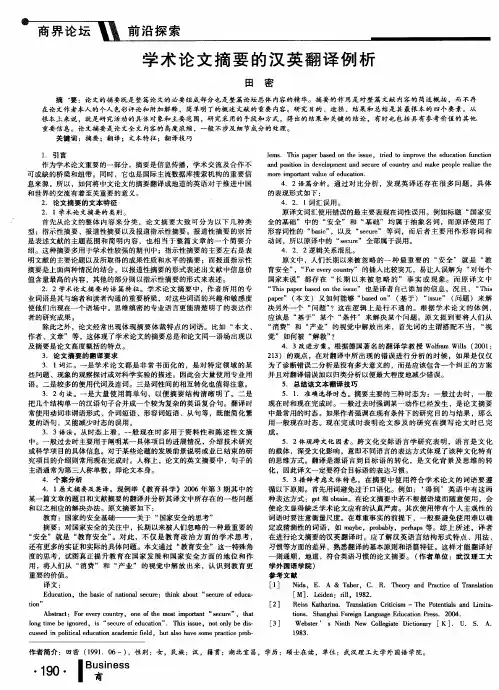
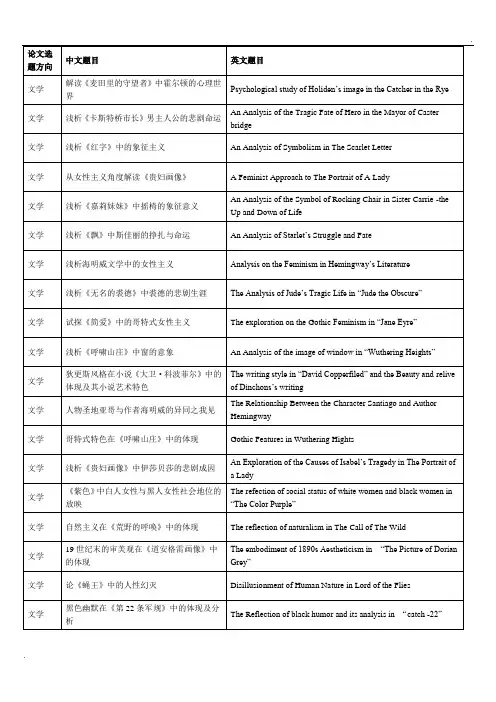
英语专业论文题目参考第一篇:英语专业论文题目参考英语专业论文题目语言与语言学类001 从历史文化的发展看某个英语词或短语的语义演变002 英诗中常用的修辞003 英语谚语的修辞手法004 委婉语种005 英语中的缩略语006 英语词汇中的外来语单词007 英语新词新意探究008 美国英语的特色009 如何正确把握英语定语从句(或其他各种从句或语法形式)在句子中的确切含义010 Fuzzy Words and Their Uses in Human Communication 011 Ambiguity and Puns in English012 Some basic consideration of style013 English by Newspaper014 English Personal Pronouns: a Preliminary Textual Analysis 015 Thematic Network and Text Types016 An Inquiry into Speech Act Theory017 On Lexical Cohesion in Expository Writing018 The Inferences of Conversational Implications019 Context and Meaning020 The Construction and Interpretation of Cohesion in T exts 语言教学类001 扩大词汇量和提高英语阅读能力的关系002 提高英语阅读速度的主要障碍003 英语阅读能力和阅读速度的关系004 通过扩大知识面提高英语阅读能力005 如何在阅读实践中提高英语阅读能力006 阅读英文报刊的好处007 如何处理精读和泛读的关系008 如何对付英语阅读材料中的生词009 如何通过阅读扩大词汇量010 提高阅读能力和提高英语听力的关系011 英语听说读写四种技能的关系012 通过英语阅读提高英语写作能力013 英语快速阅读能力的构成成分014 中学生英语自主学习能力的培养015 英语教学中的语言焦虑及解决策略016 简笔画-英语教学中简单高效的教学手段017 提高英语听力理解能力的策略和技巧018 电子辞典与英语教学019 普通话对英语语音的迁移作用020 母语迁移在基础教育各阶段中的作用021 提高大班课堂教学的效果022 《英语课程标准》研究023 口语教学中教师的角色024 从心理学角度探讨少儿英语教学025 英语课堂提问的策略研究026 英语后进生产生的原因以及补差方法研究027 英语词汇教学方法探讨028 小学生英语口语能力评估方法研究029 朗读在英语教学中的作用030 任务型教学法研究031 方言对学生英语语音的影响032 英语阅读课堂教学模式探讨033 英语课堂的合作学习策略研究034 中学生英语学习策略的培养035 探究式教学法在中学英语教学中的应用036 现代信息技术在英语教学中的应用037 教师教学行为对高中生英语学习的影响038 实施成功教育减少两极分化039 小学英语活动课教学模式研究040 中学英语听力训练最佳方案041 原版电影与英语学习042 中学生英语兴趣的培养043 《疯狂英语》(或各种教学方式)的利与弊044 张思中教学法实践调查报告045 如何杜绝中式英语046 英语教师的文化素养047 网络时代如何学好英语048 背景知识与阅读理解049 上下文在阅读理解中的作用050 家庭教师在中学生英语学习中的利弊051 中学英语教学现状分析052 中学英语课堂上的Daily Report053 中外教师解释课文方法比较054 中外教师课堂提问方法比较055 中外教师课堂鼓励性用语比较056 中外教师对学生总体要求之比较057 计算机辅助英语教学中的诸问题058 不同种类的计算机辅助英语教学方式059 计算机辅助英语教学中的教学法原则060 The Instructive Meaning of Inter-language Pragmatics for foreign Language Teaching061 Pedagogical Translation and Translation Teaching062 The Importance of Cultural Authenticity in TeachingMaterials063 Micro-teaching and Student Teacher Training064 How to Evaluate the Teacher Performance-A Case Study 065 English Test Design 066 The Interference of Native Language in English Writing or Translation 067 Translation Methods and English Teaching第二篇:英语专业论文题目英语专业论文题目大全好的论文题目既是研究的方向,也是一个新的学习领域。
毕业设计(论文)外文文献翻译要求为提高毕业设计(论文)的质量,加强毕业设计(论文)规范性,经研究决定,2008届毕业论文(设计)要求翻译2篇外文文献(每篇译文的中文字数一般要求2000-3000左右)或外文字符不少于1.5万。
翻译的外文文献应主要选自学术期刊、学术会议的文章、有关著作及其他相关材料,应与毕业论文(设计)主题相关,并作为外文参考文献列入毕业论文(设计)的参考文献。
并在每篇中文译文首页用“脚注”形式注明原文作者及出处,中文译文后应附外文原文。
中文译文的基本撰写格式为题目采用小三号黑体字居中打印,正文采用小四号宋体字,行间距一般为固定值20磅,标准字符间距。
页边距为左3cm,右2.5cm,上下各2.5cm,页面统一采用A4纸,使用学校统一规定的封面格式,并按“封面、译文一、外文原文一、译文二、外文原文二、外文翻译考核表”的顺序统一装订,与开题报告一同提交。
东莞理工学院软件学院二○○八年二月二十六日东莞理工学院软件学院毕业设计(论文)外文文献翻译毕业设计(论文)题目翻译(1)题目翻译(2)题目学院计算机学院专业姓名班级学号指导教师外文翻译考核表我的大学爱情观目录:一、大学概念二、分析爱情健康观三、爱情观要三思四、大学需要对爱情要认识和理解五、总结1、什么是大学爱情:大学是一个相对宽松,时间自由,自己支配的环境,也正因为这样,培植爱情之花最肥沃的土地。
大学生恋爱一直是大学校园的热门话题,恋爱和学业也就自然成为了大学生在校期间面对的两个主要问题。
恋爱关系处理得好、正确,健康,可以成为学习和事业的催化剂,使人学习努力、成绩上升;恋爱关系处理的不当,不健康,可能分散精力、浪费时间、情绪波动、成绩下降。
因此,大学生的恋爱观必须树立在健康之上,并且树立正确的恋爱观是十分有必要的。
因此我从下面几方面谈谈自己的对大学爱情观。
2、什么是健康的爱情:1)尊重对方,不显示对爱情的占有欲,不把爱情放第一位,不痴情过分;2)理解对方,互相关心,互相支持,互相鼓励,并以对方的幸福为自己的满足;3)是彼此独立的前提下结合;3、什么是不健康的爱情:1)盲目的约会,忽视了学业;2)过于痴情,一味地要求对方表露爱的情怀,这种爱情常有病态的夸张;3)缺乏体贴怜爱之心,只表现自己强烈的占有欲;4)偏重于外表的追求;4、大学生处理两人的在爱情观需要三思:1.不影响学习:大学恋爱可以说是一种必要的经历,学习是大学的基本和主要任务,这两者之间有错综复杂的关系,有的学生因为爱情,过分的忽视了学习,把感情放在第一位;学习的时候就认真的去学,不要去想爱情中的事,谈恋爱的时候用心去谈,也可以交流下学习,互相鼓励,共同进步。
外文翻译的格式要求
一、封面
1、已填写的内容不要改动
2、外文出处只能填写著作名、教材名、英文论文题目、英语国家官
方网页网址、期刊名、报纸名。
中文网址禁止填写。
二、外文翻译文件排列顺序
首先是封面,然后是译文即中文,其次另起一页英文即原文,最后一页是外文资料翻译评价表(由指导教师填写)。
三、译文部分格式要求
1、题目为宋体四号居中加粗
2、正文内容为宋体小四,行间距为固定值18磅,其他数值为0
四、原文格式要求
字体为Times New Roman ,其他与原文相同。
论文题目翻译的一般方法与原则论文题目翻译的一般方法与原则论文题目的英文翻译在论文中一方面反映论文的主要内容,那么如何翻译论文的题目呢?下面应届毕业生小编就为大家介绍论文题目翻译的一般方法与原则吧!(一)吃透题目的基本内容。
一般而言,论文题目的翻译与论文全文的翻译过程一样,都要经过理解和表达的过程。
在论文题目的翻译实践中,理解是表达的前提,不能正确的理解就谈不上确切的表达。
要准确地英译论文的题目,首先要吃透题目的基本内容,这涉及到理解题目的主题、立意、内在与外在的含义、作者的观点以及研究的方法和内容等。
为了透彻理解论文题目原意,译者往往得联系上下逻辑关系,仔细推敲,分析来龙去脉,有时甚至要细读全文或与作者本人交流,了解题目的真正内容,方可落笔成文。
例如:论《野草》On Ye Cao (Wild Grass)Written byLuXun(1881-1936)若根据汉语拼音翻译成On Ye Cao ,外国读者会不知所云,所以,英译论文题目应吃透其基本内容和含义,仔细玩味,尊重论文作者的思想,而不可望文生义、草率落笔。
(二)找准题目的中心词。
英译论文题目,首先要找准中文题目中的中心词,并突出其显着位置。
由于汉语论文题目常有一大堆修饰、说明或限制的词或词组置于中心词之前,采用偏正结构的词组形式。
而英译时需先将中心词提前,再附加一些限制、修饰语,并将与这个中心词有关的词和词组找出来,用连词或介词连结成为一个短语。
例如:翻译教材中译例的编选原则(上海科技翻译,2004.3)Principles of Illustrative Examples in Com-pilingTranslation Textbooks首先找准该中文题目的中心词是“原则”,英译时译出中心词principles置于首位;而“原则”是属于“译例的原则”,即principles of IllustrativeExamples,然后译出附加语“编写翻译教材中”为in compilingtranslation textbooks.智能车光电传感器和摄像头的选择(扬州职业大学学报,2011.4)Choice of Photoelectric Sensor and Camerain Intelligent Car(三)注重题目的简单明了。
毕业设计/论文开题报告课题名称院系专业班姓名评分指导教师华中科技大学武昌分校毕业设计开题报告撰写要求1. 开题报告主要内容1)课题设计的目的和意义;2)课题设计的主要内容;3)设计方案;4)实施计划。
5)主要参考文献:不少于5篇,其中外文文献不少于1篇。
2.撰写开题报告时,所选课题的课题名称也不得多于25个汉字,课题设计份量要适当,设计中必须是自己的设计内容。
3. 开题报告的字数不少于2000字(艺术类专业不少于1000字),格式按《华中科技大学武昌分校本科毕业设计/论文撰写规范》的要求撰写。
4. 指导教师和责任单位必须审查签字。
5.开题报告单独装订,本附件为封面,后续表格请从网上下载并用A4纸打印后填写。
6. 此开题报告适用于全校各专业,部分特殊专业需要变更的,由所在系在基础上提出调整方案,报学校审批后执行。
华中科技大学武昌分校学生毕业设计开题报告毕业设计/论文外文文献翻译院系专业班级姓名原文出处评分指导教师华中科技大学武昌分校20 年月日毕业设计/论文外文文献翻译要求:1.外文文献翻译的内容应与毕业设计/论文课题相关。
2.外文文献翻译的字数:非英语专业学生应完成与毕业设计/论文课题内容相关的不少于2000汉字的外文文献翻译任务(其中,汉语言文学专业、艺术类专业不作要求),英语专业学生应完成不少于2000汉字的二外文献翻译任务。
格式按《华中科技大学武昌分校本科毕业设计/论文撰写规范》的要求撰写。
3.外文文献翻译附于开题报告之后:第一部分为译文,第二部分为外文文献原文,译文与原文均需单独编制页码(底端居中)并注明出处。
本附件为封面,封面上不得出现页码。
4.外文文献翻译原文由指导教师指定,同一指导教师指导的学生不得选用相同的外文原文。
华中科技大学武昌分校本科毕业设计/论文撰写规范毕业设计/论文是学生在教师的指导下经过调查研究、科学实验或工程设计,对所取得成果的科学表述,是学生毕业及学位资格认定的重要依据。
杭州电子科技大学信息工程学院毕业论文外文文献翻译要求根据《普通高等学校本科毕业设计(论文)指导》的内容,特对外文文献翻译提出以下要求:一、翻译的外文文献可以是一篇,也可以是两篇,但总字符要求不少于1.5万(或翻译成中文后至少在3000字以上)。
二、翻译的外文文献应主要选自学术期刊、学术会议的文章、有关著作及其他相关材料,应与毕业论文(设计)主题相关,并作为外文参考文献列入毕业论文(设计)的参考文献。
并在每篇中文译文首页用“脚注”形式注明原文作者及出处,中文译文后应附外文原文。
三、中文译文的基本撰写格式为:1.题目:采用小三号、黑体字、居中打印;2.正文:采用小四号、宋体字,行间距一般为固定值20磅,标准字符间距。
页边距为左3cm,右2.5cm,上下各2.5cm,页面统一采用A4纸。
四、封面格式由学校统一制作(注:封面上的“翻译题目”指中文译文的题目),并按“封面、译文一、外文原文一、译文二、外文原文二、考核表”的顺序统一装订。
五、忌自行更改表格样式。
毕业论文外文文献翻译毕业设计(论文)题目Xxx翻译(1)题目指翻译后的中文译文的题目翻译(2)题目指翻译后的中文译文的题目系会计系以本模板为准)专业XXXXXX(以本模板为准)姓名XXXXXX(以本模板为准)班级XXXXXX(以本模板为准)学号XXXXXX(以本模板为准)指导教师XXXXXX(以本模板为准)正文3杭州电子科技大学信息工程学院本科毕业论文文献综述的写作要求为了促使学生熟悉更多的专业文献资料,进一步强化学生搜集文献资料的能力,提高对文献资料的归纳、分析、综合运用能力及独立开展科研活动的能力,现对本科学生的毕业设计(论文)提出文献综述的写作要求,具体要求如下:一、文献综述的概念文献综述是针对某一研究领域或专题搜集大量文献资料的基础上,就国内外在该领域或专题的主要研究成果、最新进展、研究动态、前沿问题等进行综合分析而写成的、能比较全面地反映相关领域或专题历史背景、前人工作、争论焦点、研究现状和发展前景等内容的综述性文章。
论文题目英文翻译格式探析论文题目(title)是论文内容的精确概括,对全文起画龙点睛的作用,译文必需言简意赅、通顺无误,论文题目的英译必须用最精炼的语言恰如其分地体现全文的主题和核心,读者才可以快速了解论文研究的主题,从而判断该文献内容对自己是否有阅读的价值,下面简析论文题目翻译格式和翻译方法。
一、论文题目英文翻译的要求。
(一)明确。
要能够揭示论文范围或论点,使人看了标题便知晓文章的大体轮廓、所论述的主要内容以及作者的写作意图,而不能似是而非,藏头露尾,与读者捉迷藏。
为了便于检索,标题中所用的词尽量使用表达全文内容的关键词。
(二)简练。
论文的标题不宜过长,过长了容易使人产生烦琐和累赘的感觉,得不到鲜明的印象,从而影响对文章的总体评价。
标题也不能过于抽象、空洞,标题中不能采用非常用的或生造的词汇,以免使读者一见标题就如堕烟海,百思不得其解,待看完全文后才知标题的哗众取宠之意。
论文题目不宜过长,大多为8~12个单词左右。
二、论文题目英文翻译的格式。
同长长的论文相比,写标题似乎是件小事,也往往被学生忽视。
甚至有些学生把标题译成一个完整的句子,还在后面加上标点,这显然是不对的。
英语标题的写法是有一定规律可循的。
一般说来,应该注意以下几点:(一)标题必须写在首行的中间。
每个标题都必须写在中间,不要太偏左或太偏右,更不要顶格空两格或直接从左边写起。
(二)如果标题太长,在一行内写不完,可以用两行来写。
用两行写标题,第二行应比第一行短,并且要放在中间。
(三)如果打印需要加黑。
一般毕业论文需要打印件,标题打印时必须加黑,且字号通常比正文大一号或两号,选择居中。
(四)标题的第一个单词和最后一个单词的首字母必须大写。
不管第一个单词和最后一个单词是什么词性,也不管它们有多长或者多短,只要它们是写在第一个或最后一个词的位置上,首字母就必须大写。
(五)所有实词的首字母都必须大写。
英语中,实词包括名词、代词、动词(含系动词、助动词、及情态动词)、形容词、副词和数词,它们出现在标题中首字母都必须大写。
(六)虚词一般不需要大写。
英语中的虚词,如冠词(a, an, the)、较短的介词(如at, by, in, on, over,with)、较短的连词(如and, but, for, nor, or)和感叹词,出现在标题中一般不用大写。
但如果是第一个单词或最后一个单词,首字母就必须大写。
有时较长的介词(如without, between)和较长的连词也可以大写。
(七)复合词中连字符号前的第一个单词的首字母大写。
如果连字符连接的是一个名词或形容词,后者认为与前面的单词在意义上同等重要,那么连字符之后的单词也可以大写。
(八)标题里可用引号和问号,一般不用句号。
标题中必要时可用引号、问号、逗号、冒号和破折号。
手写使用下划线标出书名或戏剧名,用引号标出文章、短篇、诗歌等的题目。
打印时用斜体字标出书名等。
例如:(1)“大学英语课堂教师话语的调查与分析”A Study of Teacher Talk in English Classes(2)“莎士比亚与哈姆莱特”Shakespeare and Hamlet(3)“连系动词SEEM的语义及句法考察”A Corpus-based Study on the Semantics and Syntax of“SEEM”三、如何英译论文题目。
在英译论文题目时,除了做到简明概括,客观准确的反映论文的主要内容,不追求语言的艺术美外,还要注意以下一些常见的问题。
(一)简明醒目,去掉谦词。
许多中文论文题目中都有“漫谈……”、“试论……”、“浅析……”、“管见……”、“……的一瞥”、“……的初探”等谦词,这些词表示作者行文谦虚,在科学上留有他人继续探讨的余地,英译时做到言简意赅,都可以省略不译。
(二)突出中心词,搭配修饰语。
英译论文题目时,首先要找到中心词,并将其放到最突出的位置上,然后找出与之相关的修饰语,构成介词短语或其它短语结构与其后置搭配,这和汉语的前置偏正结构修饰语正好相反。
(三)符合英语语言规范,用短语代替句子。
1.名词性词组标题中用得最多的是名词或名词词组,一般不用动词或动词词组。
如果用动词,则用非谓语动词形式,如动名词、不定式或分词。
例如:“认知语言学与语篇分析”:Cognitive Linguistics and Discourse Analysis“提高英语教师的口语技能”:Improving English Teacher Talk“如何激发非英语专业的学生掌握英语”:How to Motivate Non-EnglishMajors to Master English2.介词词组除名词外,用得较多的是介词词组,有时使用形容词、冠词、连词、副词。
介词词组由介词十名词或名词词组构成,如果整个标题就是一个介词词组的话,一般这个介词是“on”,意思是“对……的研究”.例如:“关于韩国语文法意识的起源”:On the Origin of Korean Grammar3.名词/名词词组+介词词组这是标题中用得最多的结构,英译时形成了一些惯用句型,例如:* A study of…的研究或探讨* An analysis of…的分析* A survey of…的调查赠送论文选题思路:毕业论文选题思路一、毕业论文选题思路确定选题是撰写论文的第一步工作。
俗话说:“题好一半文”,就是把选题看作论文写作成功的一半。
所以对一个初学论文写作的学生来说,确定好选题,更是论文写作成功的关键。
除了要考虑有无社会价值(围绕现实经济生活中的重点、难点和热点来做选题)、自身的知识结构、专业特点、资料来源的难易程度、时间上的保证等因素外,一个论文选题的确定有它的思路:1、热门与冷门的选择热门选题的好处:一是资料容易搜集,一段时间内各种媒体会有较多的相关资料信息出现;二是在现实经济生活中,对于这类问题,你有切身的感受;三是一旦你写得好就有机会被有关报纸、杂志采纳。
其缺点是,一个选题有许多学生选,大家搜集资料的来源差不多,写出来的文章七拼八凑,从内容到结构都差不多,难出新意。
指导老师看到这类文章自然不可能给出好成绩。
如笔者去年指导的高职市场营销毕业班的11篇论文,有415篇,就是一个选题,从品牌到名牌。
从中可以看出来,学生搜集资料的来源有网络、杂志,文章中使用的案例也差不多,照搬照抄的为多数,根本没有自己的语言。
品牌研究是前几年最热门的话题,这方面的研究太多,你就很难有自己新的观点。
当然,在这个选题下,你从另一个角度(不要与多数论文的角度一样),对标题重新设计,内容突出现在企业最关心品牌的问题作更深人的探讨,穿插具说服力的案例,也许会是一篇好文章。
冷门选题也是相对而言的,对学生来说,也就是选得少或不选,资料搜集较难的选题,但也必须具有学术价值和实际应用价值,而不是指脱离经济生活,太陈旧的选题。
如笔者去年出版了《招商学》一书。
2002年我们在做这么一个选题时,就发现几年来全国招商引资工作做得红红火火,市场上描写招商引资工作的书也有,但极少,各地招商引资以各部门为主都编辑了手册,但真正把招商引资作为一门学科来研究的尚没有;同时,在搜集资料的过程中,了解到各招商引资机构缺的就是这样一本,能够指导他们具体工作的工具类性质的书。
招商引资机构有许多的实例,但很少有人把它上升到理论的高度。
这一年中,搜集资料的困难太多了,似无资料可搜集,只能从边缘学科中去参考和借鉴。
因此,选择这一类“冷门”的选题更容易获得写作上的成功。
是选“热门”选题,还是选“冷门”选题,这要根据你自身的情况来定。
“冷门”选题搜集资料难,你会付出比别人多的劳动,但往往会有好的收获,即论文成绩高于别的同学。
2、大题与小题的选择大题涉及面广,可写的东西多,但不容易写深,四面出击,面面俱到,只能是泛泛而谈,也容易出现漏洞。
如论中国的企业文化,题目太大,这个题目应该是可以写出一本书的题目,一篇5,000字左右的论文如何论述得清楚,只能是一些条条框框,文章不容易写深。
如在这个大选题下选一个小选题:中国企业如何建设自己的文化或中国企业文化建设的一些构想等就可将文章写得深入了。
小题虽然可集中精力,但也不能太小,没有足够的拓展空间,又可能达不到毕业论文的要求(5,000字左右),从而把自己限制得太死,搜集起来的资料也没办法安排到文章中去。
对于初学写论文的学生来说,选题宜小不宜大,宜具体不宜抽象,宜限定不宜宽泛。
如“论企业改革”、“论国有企业改革”、“论国有企业产权制度改革”、“论国有企业产权制度改革--由某某公司股份制改革谈起”.这四个题目,一个比一个小,一个比一个具体。
相对而言,写作难易程度也一个比一个容易。
3、选题与实践的结合选题无非有二种情况:一是确定选题后搜集资料,有局限性(一般学校都这样要求);二是围绕某一方面,在占有资料基础上或有实践经验基础上确定小的选题(这种较科学和合理)。
如果你遵循正确的选题思路,确定好选题以后,开始搜集资料,撰写提纲,按要求写出论文固然最好,但也存在一些特殊的情况:你们的毕业论文实际上是在你们下个学期参与实习或实践,或就业一段时间后再完成,毕业前夕再交回学校。
这样就可能出现这样的情况:一是有的学生受到实际工作的启示,或受实习环境的影响,觉得原来在学校的选题太大难于写好,不如换一个小一点的题目,比较容易把握。
这就结合实际工作对选题作了变动,更具现实意义。
这时,学生应该主动与指导老师取得联系,指导老师同意后再作变动。
作为指导老师,对于情况属实的,应鼓励学生,让学生写出更好的毕业论文。
如,有一位学生在一家外资企业实习,发现做好吸引外商投资工作对企业发展影响大,而当前这方面工作存在不少问题有待探讨。
这就对自己原先的选题作了变动。
该学生对新的选题不仅感兴趣,而且搜集了许多相关资料,还得到企业老总的支持。
最后,该生的毕业论文既为企业老总出谋划策,又被学校评为优秀毕业论文。
当然,学生一旦确定选题后,没有特殊理由,一般不主张随意变动,因为选题变动太随意,学校不好管理,指导老师也没办法把握,而学生自己最终可能把握不好,失去成功写作论文的机会,即三心二意,时间浪费了,到最后一团槽。
笔者主张在大选题上再选小选题。
所以,学生在做选题时应选大一点的选题,待某一方面搜集好资料后,再做小选题,这样不容易把自己限定太死。
4、给论文列出一个时间表以3个月左右来按排论文写作的时间表开始动笔(2月底)完成第一稿(6周)导师审阅(1周)完成第二稿(3周)导师审阅(1周)完成第三稿(2周)导师审阅(1周)定稿(1周)。